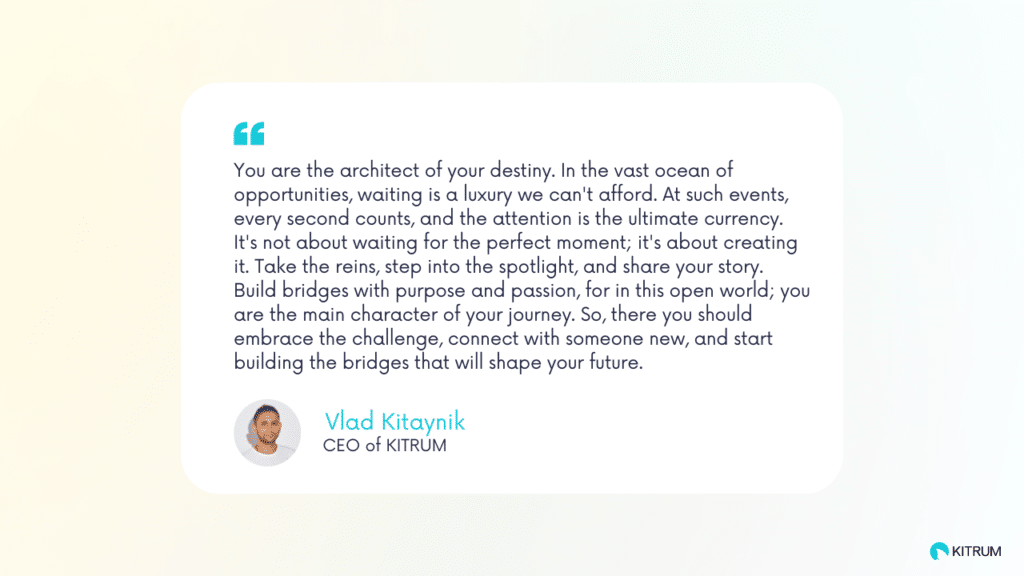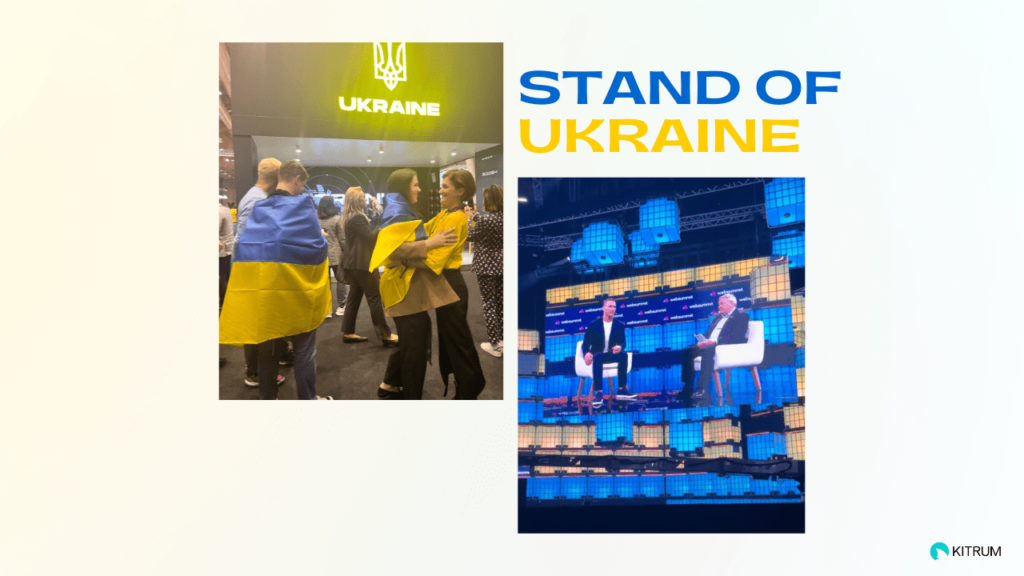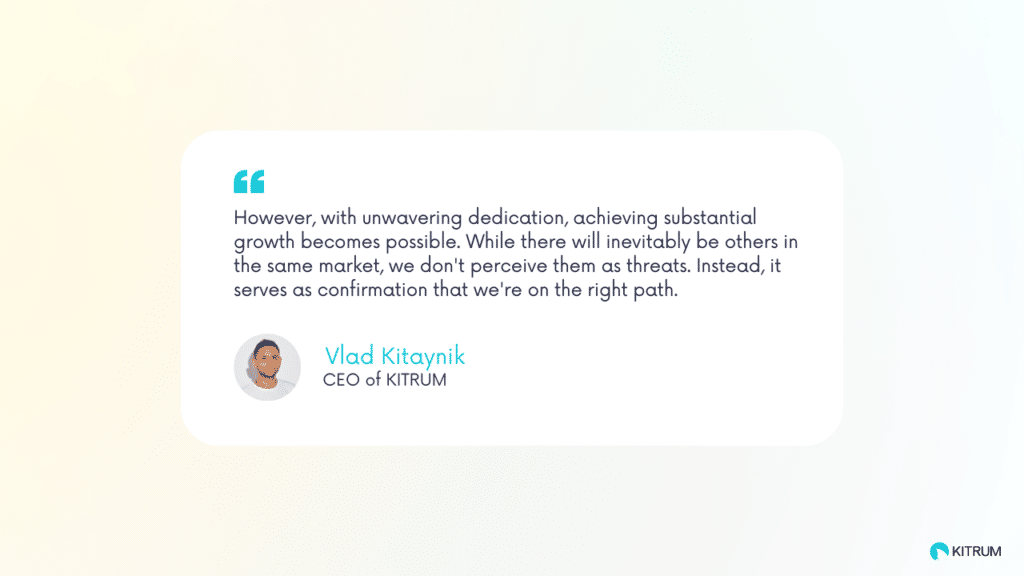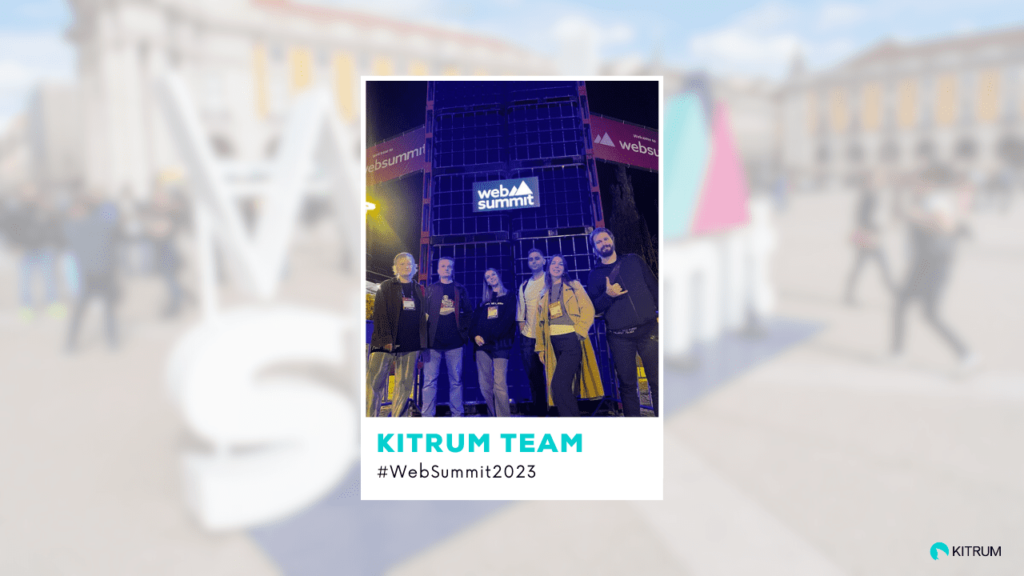“Great things never come from comfort zones; they come from networking zones,” – following this belief, the Kitrum team has recently visited the Web Summit 2023 in Portugal. The team, led by CEO Vlad Kytainyk, has actively participated in the event, diving into the bustling networking zones to connect with industry leaders, fellow entrepreneurs, and potential partners.
But before we delve into our firsthand account of WebSummit 2023, let me give you a quick overview of the event. So, a little bit of numbers:
- 70, 236 attendees from 153 countries;
- 2, 608 startups;
- 906 investors;
- 2, 100+ media representatives.
In our exclusive interview with Vlad, he shared invaluable insights gained during the summit, key takeaways, areas for improvement, and even valuable advice for those attending Web Summit for the first time next year. Without further ado, let’s ask him some questions.
Overall experience
Could you share your thoughts on the overall impression you gained from your participation in Web Summit 2023?
Reflecting on Web Summit 2023, the experience was overwhelmingly positive from every perspective. We’ve wanted to visit the summit for a while and finally made it happen this year. The timing was also significant, coinciding with a period of substantial industry changes and certain reputational challenges for Web Summit. Despite the absence of some major companies, we still decided to attend, wanting to experience the atmosphere firsthand. And as we expected, it turned out to be a fantastic decision.
Were there any specific moments or sessions at Web Summit 2023 that stood out to you?
In my opinion, Web Summit is all about chaotic networking and building bridges between people, companies, and countries, and what struck me most was the realization that each attendee holds the power to shape their experience.

How do you approach networking at this event?
At first, I thought a humble approach was best, but at the Web Summit, the game changed. Everyone was open to connections. So, I switched gears, initiating honest conversations. The result? Honesty and straightforwardness proved fantastic, leading to valuable connections and partnerships.
Our solution architect, Alex Zamai, stood out with a remarkable conversion. In total, we engaged with close to 300 individuals, including around 70 startups and 30 country booths. Notably, we forged a memorandum for partnership with ClickUp, a company we extensively use in our daily working processes. Several other exciting conversations are in the pipeline, ready to be announced soon.
What do you think about the side events at Web Summit? Is it worth checking them out, considering there are so many during the summit?
The Web Summit’s goal is clear: expansion. As a result, they really nailed it with a multitude of side events. So, yes, exploring the side events at the Web Summit can be a worthwhile experience. It provides a comprehensive understanding of the event’s overall vibe. Just ensure you have enough energy for the evening events, as the daytime exploration can easily lead to up to 30,000 steps – a great physical exercise.
In brief, how would you describe the overall audience at Web Summit? Can you provide a snapshot of the diverse people attending the event?
The audience is mainly digital hustlers, which reminds me of the historical quest for quick wealth on the West Coast of the United States, akin to the gold rush in San Francisco. Similarly, many here seek rapid growth, thinking, “Give me my first substantial funding – around 500,000 to 1 million. If it succeeds, great. If not, at least I’ll have some fun.” The audience can be described as digital adventurists; some casually explore partnerships with like-minded individuals.
Based on my observation, the approach shouldn’t be heavily pitching ideas. Instead, it’s about building a rapport, aligning values, and sharing perspectives on how they see the world. This contrasts with the Hollywood landscape, where actors vie for roles, and producers scout for talent. This has been my insightful experience around Web Summit.
If you had the chance to give feedback directly to the Web Summit team, what would you tell them? Are there specific aspects of the Web Summit experience you’d like to see improved based on your feedback?
According to our experience, the Web Summit team could significantly improve the user experience with a better mobile app. A well-designed mobile app enriched with quick messaging or audio features could greatly simplify the networking experience. At Kitrum, we will be more than happy to assist Web Summit and its organizers in improving this aspect.
Besides, Web Summit plans to expand into Brazil and Qatar next year, reaching into Latin America and the Middle East. As a suggestion, looking ahead to the next two years, it might be worthwhile for Web Summit to consider expanding its footprint to Central and Eastern Europe, specifically Ukraine. This could serve as an excellent showcase of how global participants can converge in Kyiv, sharing ideas and leveraging innovations and startups to contribute value to the revitalization of Ukraine.

Regarding Ukraine, what are your thoughts on the country’s presence at the Web Summit? How many people or companies from Ukraine did you encounter, and what’s your perspective on Ukraine’s representation at this year’s event?
It was a positive experience at the stand of Ukraine, featuring engaging people, insightful lectures, and fascinating startups. I believe we effectively presented ourselves, especially with Wladimir Klitschko drawing a substantial audience and receiving positive feedback for his impactful message.
Discussing delicate topics related to Ukraine, including the impact of the war, with mature investors and representatives from other countries added depth to our conversations. I was pleased to see people remembering and acknowledging the ongoing situation in Ukraine. This emotional connection is crucial and adds significant value to our presence at the event.
Now that the Web Summit is over and you have specific goals and strategies in mind, what are your next steps? How do you plan to leverage the connections and results you’ve gained from the event, and what does your post-Web Summit plan look like?
We’ve already contemplated directions as AI, AR/VR, and insights that we brought from the Web Summit reinforce our commitment to delve deeper into these areas. So, we are looking ahead confidently, knowing that we’re on the right track and that there’s a demand for what we’re planning.
We are also committed to maintaining and advancing our established connections. We will stay in touch with those who currently don’t require assistance and explore potential opportunities with those who could benefit from our services. The conclusion of the Web Summit doesn’t mean the end of our efforts; our marketing team is developing plans for ongoing relationship marketing activities with individuals we’ve connected with. We anticipate seeing more results in the next three to six months.
Besides AI, what key industry trends and insights did you personally notice from a technology perspective?
Web Summit 2023 showcased a tech landscape dominated by AI innovations – AI-powered diets, weather analysis, and much more.
AR and VR, particularly discussions about Apple’s Vision Pro, grabbed much attention. Although not seen as the metaverse, people found these technologies interesting, and they are expected to stick around. Surprisingly, startups didn’t pay much attention to improving personal productivity and mental health, revealing a gap in addressing human challenges with growing work demands. The focus was on developing a version that can act independently — a concept actively being worked on, exploring the idea of creating a digital twin or avatar for productivity.
The summit highlighted a commitment to sustainability, focusing on renewable energy, recycling, and eco-friendly packaging innovations. For example, one Ukrainian startup in the semifinals proposed a plant-based solution for cosmetics packaging, aligning with the theme of saving our planet.
Moving beyond technology, mental health became a prominent focus, addressing a crucial 21st-century challenge. However, while startups and AI-powered solutions aim to tackle it, the complexity of finding balance amid information overload still remains.
During the event, did you encounter any noteworthy competitors in your industry? Were there specific conversations or observations that caught your attention regarding their activities within your niche?
It is true that we’re in a highly competitive industry – a red ocean where opportunities are hard-fought. In such an environment, success hinges on factors like innovation, efficient operations, and a deep understanding of consumer needs. We compete with various companies, different countries, and diverse reputations, making it far from easy.

What are your thoughts on having your own booth next year? Do you have any specific ideas or opinions on the matter?
Looking ahead to next year, our approach to Web Summit will be a whole new ballgame. The fact is that no amount of preparation, whether through books or videos, fully readies you until you’re in the midst of it. Now, armed with our own experience, next year promises new strategies. We’ll be presenting a booth, and our outreach will span from alpha startups to beta, growth, investors, and country representatives.
I strongly believe that creativity is the key to standing out at Web Summit. The conventional booths with laptops and typical pitches seem too common, and Kitrum is eager for something unconventional and massive for our next visit. I want our presentation to be unique and memorable, breaking away from the ordinary. The goal is to create an impression that sets us apart amid thousands of pitches with similar plates.
For those entrepreneurs attending Web Summit for the first time, what advice would you offer based on your experience?
Attending an event like a Web Summit is valuable. First and foremost, you need to understand that the experience becomes more fruitful if you have a basic understanding of business dynamics, investment relationships, and how to craft a startup pitch deck. While enjoying the social aspect is enjoyable, a minimal level of preparation can lead to quality connections and unexpected outcomes with long-term benefits.
- Definitely, do your best to prepare thoroughly;
- Don’t feel disheartened if you can’t prepare for everything;
- Reserve at least 40% for unexpected events or spontaneity;
- Going solo isn’t the ideal approach; it’s much better to go with teammates as it facilitates better understanding and digestion of information. You can gather all the information afterward. It’s not just about your personal experience; you can share it with others, receive feedback, and refine your own perspective on things.

Participating in Web Summit is also a way to share your ideas with the public and observe the feedback or reflections they generate. This is something that is hard to plan and may occur periodically. However, when it does happen, trust the experience, and whatever unfolds, let it happen.
As an entrepreneur, what advice would you offer to others in terms of preparing for the Web Summit?
For entrepreneurs planning their first Web Summit experience, my advice is simple: get your ticket, book a nearby hotel within walking distance, and immerse yourself in the vibrant atmosphere. Keep your expectations realistic to avoid potential disappointment, but trust the experience and enjoy the unique opportunity to be surrounded by thousands of intelligent, ambitious individuals. And, of course, don’t forget to treat yourself to some grilled octopus after the event – it’s a must-try!







